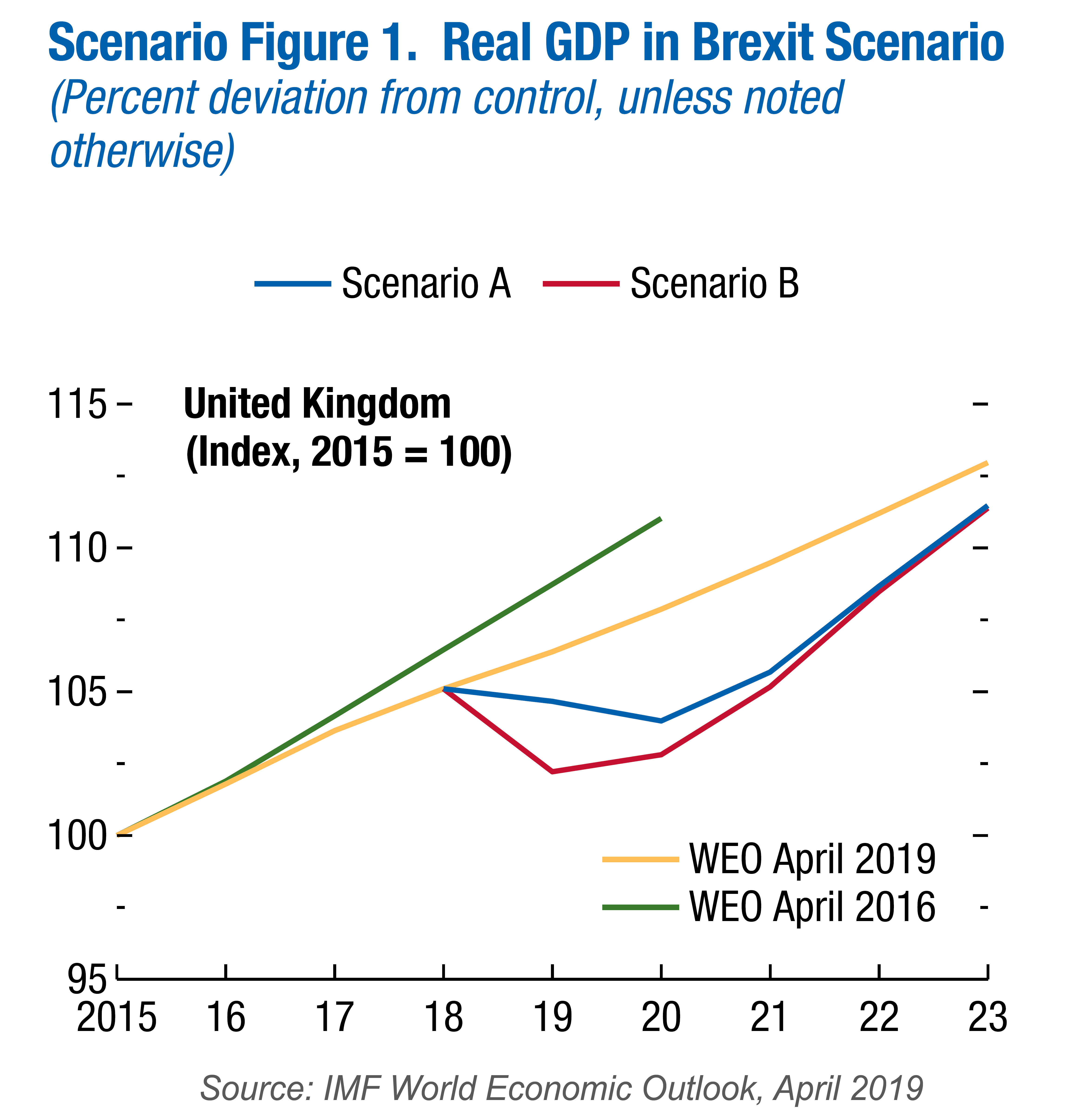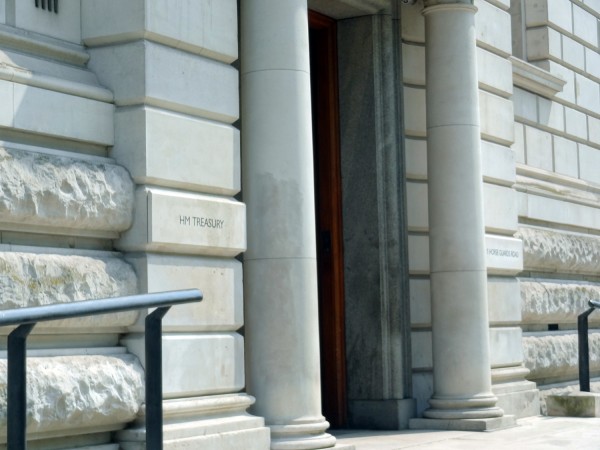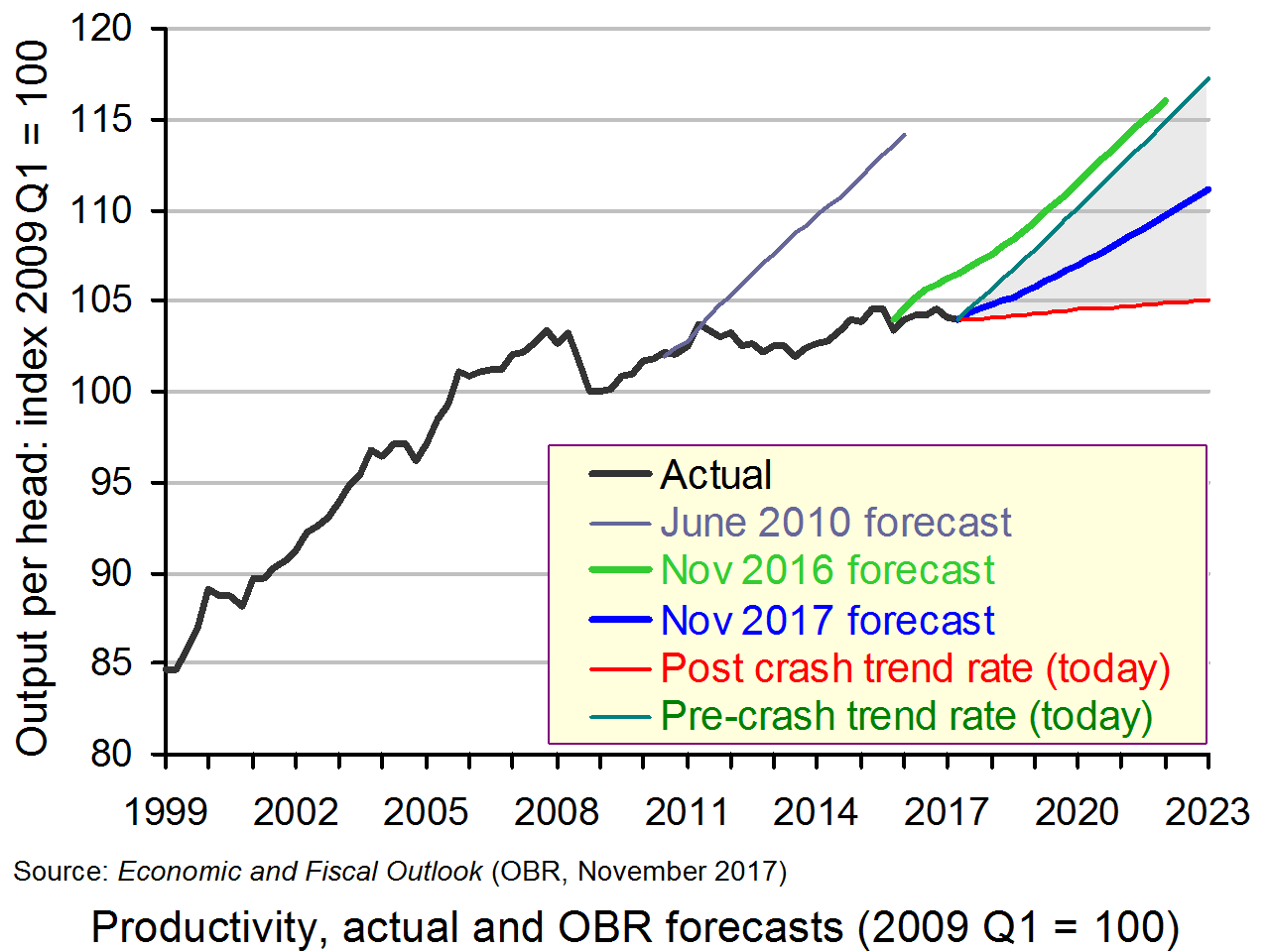 There have been many analyses of the economic effects of Brexit, both before the referendum and at various times since, including analyses of the effects of the deal negotiated by Theresa May’s government and the EU. But with the prospect of a no-deal Brexit on 31 October under the new Boris Johnson government, attention has turned to the effects of leaving the EU without a deal.
There have been many analyses of the economic effects of Brexit, both before the referendum and at various times since, including analyses of the effects of the deal negotiated by Theresa May’s government and the EU. But with the prospect of a no-deal Brexit on 31 October under the new Boris Johnson government, attention has turned to the effects of leaving the EU without a deal.
There have been two major analyses recently of the likely effects of a no-deal Brexit – one by the International Monetary Fund (IMF) and one by the Office for Budget Responsibility (OBR).
IMF analysis
The first was in April by the IMF as part of its 6-monthly World Economic Outlook. In Scenario Box 1.1. ‘A No-Deal Brexit’ on page 28 of Chapter 1, the IMF looked at two possible scenarios.
Scenario A assumes no border disruptions and a relatively small increase in UK sovereign and corporate spreads. Scenario B incorporates significant border disruptions that increase import costs for UK firms and households (and to a lesser extent for the European Union) and a more severe tightening in financial conditions.
 Under both scenarios, UK exports to the EU and UK imports from the EU revert to WTO rules. As a result, tariffs are imposed by mid-2020 or earlier. Non-tariff barriers rise at first but are gradually reduced over time. Most free-trade arrangements between the EU and other countries are initially unavailable to the UK (see the blog EU strikes major trade deals) but both scenarios assume that ‘new trade agreements are secured after two years, and on terms similar to those currently in place.’
Under both scenarios, UK exports to the EU and UK imports from the EU revert to WTO rules. As a result, tariffs are imposed by mid-2020 or earlier. Non-tariff barriers rise at first but are gradually reduced over time. Most free-trade arrangements between the EU and other countries are initially unavailable to the UK (see the blog EU strikes major trade deals) but both scenarios assume that ‘new trade agreements are secured after two years, and on terms similar to those currently in place.’
Both scenarios also assume a reduction in net immigration from the EU of 25 000 per year until 2030. Both assume a rise in corporate and government bond rates, reflecting greater uncertainty, with the effect being greater in Scenario B. Both assume a relaxing of monetary and fiscal policy in response to downward pressures on the economy.
The IMF analysis shows a negative impact on UK GDP, with the economy falling into recession in late 2019 and in 2020. This is the result of higher trade costs and reduced business investment caused by a poorer economic outlook and increased uncertainty. By 2021, even under Scenario A, GDP is approximately 3.5% lower than it would have been if the UK had left the EU with the negotiated deal. For the rest of the EU, GDP is around 0.5% lower, although the effect varies considerably from country to country.
The IMF analysis makes optimistic assumptions, such as the UK being able to negotiate new trade deals with non-EU countries to replace those lost by leaving. More pessimistic assumptions would lead to greater costs.
OBR analysis
Building on the analysis of the IMF, the Office for Budget Responsibility considered the effect of a no-deal Brexit on the public finances in its biennial Fiscal risks report, published on 17 July 2019. This argues that, under the relatively benign Scenario A assumptions of the IMF, the lower GDP would result in annual public-sector net borrowing (PSNB) rising. By 2021/22, if the UK had left with the deal negotiated with the EU, PSNB would have been around £18bn. A no-deal Brexit would push this up to around £51bn.

According to the OBR, the contributors to this rise in public-sector net borrowing of around £33bn are:
- A fall in income tax and national insurance receipts of around £16.5bn per year because of lower incomes.
- A fall in corporation tax and expenditure taxes, such as VAT, excise duties and stamp duty of around £22.5bn per year because of lower expenditure.
- A fall in capital taxes, such as inheritance tax and capital gains tax of around £10bn per year because of a fall in asset prices.
- These are offset to a small degree by a rise in customs duties (around £10bn) because of the imposition of tariffs and by lower debt repayments (of around £6bn) because of the Bank of England having to reduce interest rates.
The rise in PSNB would constrain the government’s ability to use fiscal policy to boost the economy and to engage in the large-scale capital projects advocated by Boris Johnson while making the substantial tax cuts he is proposing. A less optimistic set of assumptions would, of course, lead to a bigger rise in PSNB, which would further constrain fiscal policy.
Articles
Video
Reports
Questions
- What are the assumptions of the IMF World Economic Outlook forecasts for the effects of a no-deal Brexit? Do you agree with these assumptions? Explain.
- What are the assumptions of the analysis of a no-deal Brexit on the public finances in the OBR’s Fiscal risks report? Do you agree with these assumptions? Explain.
- What is the difference between forecasts and analyses of outcomes?
- For what reasons might growth over the next few years be higher than in the IMF forecasts under either scenario?
- For what reasons might growth over the next few years be lower than in the IMF forecasts under either scenario?
- For what reasons might public-sector net borrowing (PSNB) over the next few years be lower than in the OBR forecast?
- For what reasons might PSNB over the next few years be higher than in the OBR forecast?
 In delivering his Budget on 22 November, Philip Hammond reported that the independent Office for Budget Responsibility had revised down its forecasts of growth in productivity and real GDP, and hence of earnings growth.
In delivering his Budget on 22 November, Philip Hammond reported that the independent Office for Budget Responsibility had revised down its forecasts of growth in productivity and real GDP, and hence of earnings growth.
Today, median earnings are £23,000 per annum. This is £1500 less than the £24,500 that the median worker earned in 2008 in today’s prices. The OBR forecasts a growth in real household disposable income of just 0.35% per annum for the next four years.
With lower growth in earnings would come a lower growth in tax revenues. With his desire to cut the budget deficit and start eventually reducing government debt, this would give the government less scope for spending on infrastructure, training and other public-sector investment; less scope to support public services, such as health and education; less scope for increasing benefits and public-sector wages.
The normal measure of productivity, and the one used by the OBR, is the value of output produced per hour worked. This has hardly increased at all since the financial crisis of 2008. It now takes an average worker in the UK approximately five days to produce the same amount as it takes an average worker in Germany four days. Although other countries’ productivity growth has also slowed since the financial crisis, it has slowed more in the UK and from a lower base – and is now forecast to rebound less quickly.
Although other countries’ productivity growth has also slowed since the financial crisis, it has slowed more in the UK and from a lower base – and is now forecast to rebound less quickly.
For the past few years the OBR has been forecasting that productivity growth would return to the trend rate of just over 2% that the UK achieved prior to 2008. For example, the forecasts it made in June 2010 are shown by the grey line in the chart, which were based on the pre-crash trend rate of growth in productivity (click on chart to enlarge). And the forecasts it made in November 2016 are shown by the pale green line. Yet each year productivity has hardly changed at all. Today output per hour is less than 1% above its level in 2008.
Now the OBR believes that poorer productivity growth will persist. It is still forecasting an increase (the blue line in the chart) – but by 0.7 of a percentage point less than it was forecasting a year ago (the pale green line): click here for a PowerPoint of the chart.
We have assumed that productivity growth will pick up a little, but remain significantly lower than its pre-crisis trend rate throughout the next five years. On average, we have revised trend productivity growth down by 0.7 percentage points a year. It now rises from 0.9 per cent this year to 1.2 per cent in 2022. This reduces potential output in 2021-22 by 3.0 per cent. The ONS estimates that output per hour is currently 21 per cent below an extrapolation of its pre-crisis trend. By the beginning of 2023 we expect this to have risen to 27 per cent.
Why has there been such weak productivity growth?
Weak productivity growth has been caused by a mixture of factors.
Perhaps the most important is that investment as a percentage of GDP has been lower than before the financial crisis and lower than in other countries. Partly this has been caused by a lack of funding for investment as banks have sought to rebuild their capital and have cut down on riskier loans. Partly it has been caused by a lack of demand for investment, given sluggish rates of economic growth and the belief that austerity will continue.

And it is not just private investment. Public-sector investment in transport infrastructure, housing and education and training has been lower than in other countries. Indeed, the poor training record and low skill levels in the UK are main contributors to low productivity.
The fall in the pound since the Brexit vote has raised business costs and further dampened demand as incomes have been squeezed.
Another reason for low productivity growth has been that employers have responded to weak demand, not by laying off workers and thereby raising unemployment, but by retaining low-productivity workers on low wages. Another has been the survival of ‘zombie’ firms, which, by paying low wages and facing ultra-low interest rates, are able to survive competition from firms that do invest.
Why is weak productivity growth forecast to continue?
 Looking forward, the nature of the Brexit deal will impact on confidence, investment, wages and growth. If the deal is bad for the UK, the OBR’s forecasts are likely to be too optimistic. As it is, uncertainty over the nature of the post-Brexit world is weighing heavily on investment as some businesses choose to wait before committing to new investment.
Looking forward, the nature of the Brexit deal will impact on confidence, investment, wages and growth. If the deal is bad for the UK, the OBR’s forecasts are likely to be too optimistic. As it is, uncertainty over the nature of the post-Brexit world is weighing heavily on investment as some businesses choose to wait before committing to new investment.
On the other hand, exports may rise faster as firms respond to the depreciation of the pound and this may stimulate investment, thereby boosting productivity.
Another factor is the effect of continuing tight Budgets. There was some easing of austerity in this Budget, as the Chancellor accepted a slower reduction in the deficit, but government spending will remain tight and this is likely to weigh on growth and investment and hence productivity.
But this may all be too gloomy. It is very difficult to forecast productivity growth, especially as it is hard to measure output in much of the service sector. It may be that the productivity growth forecasts will be revised up before too long. For example, the benefits from new technologies, such as AI, may flow through more quickly than anticipated. But they may flow through more slowly and the productivity forecasts may have to be revised down even further!
Articles
The OBR’s productivity “forecast” Financial Times, Kadhim Shubber
U.K. Faces Longest Fall in Living Standards on Record Bloomberg, Simon Kennedy and Thomas Penny (23/11/17)
Britain’s Productivity Pain Costs Hammond $120 Billion Bloomberg, Fergal O’Brien (22/11/17)
OBR slashes Britain’s growth forecast on sluggish productivity and miserly pay The Telegraph, Tim Wallace (22/11/17)
Budget 2017: Stagnant earnings forecast ‘astonishing’ BBC News (23/11/17)
Economists warn Budget measures to lift productivity fall short Financial Times, Gavin Jackson and Gill Plimmer (22/11/17)
Why the economic forecasts for Britain are so apocalyptic – and how much Brexit is to blame Independent, Ben Chu (24/11/17)
Growth holds steady as economists doubt OBR’s gloom The Telegraph, Tim Wallace (23/11/17)
Britain’s debt will not fall to 2008 levels until 2060s, IFS says in startling warning Independent, Lizzy Buchan (23/11/17)
Philip Hammond’s budget spots Britain’s problems but fails to fix them The Economist (22/11/17)
Debunking the UK’s productivity problem The Conversation, Paul Lewis (24/11/17)
Budget 2017: experts respond The Conversation (22/11/17)
Autumn Budget 2017 Forecasts Mean ‘Longest Ever Fall In Living Standards’, Says Resolution Foundation Huffington Post, Jack Sommers (23/11/17)
It May Just Sound Like A Statistic, But Productivity Growth Matters For All Of Us Huffington Post, Thomas Pope (24/11/17) (see also)
UK prospects for growth far weaker than first predicted, says OBR The Guardian, Angela Monaghan (22/11/17)
UK faces two decades of no earnings growth and more austerity, says IFS The Guardian, Phillip Inman (23/11/17)
Age of austerity isn’t over yet, says IFS budget analysis The Guardian, Larry Elliott (23/11/17)
Summary of Budget measures
Budget 2017: FT experts look at what it means for you Financial Times (24/11/17)
Official Documents
Autumn Budget 2017 HM Treasury (22/11/17)
Economic and fiscal outlook – November 2017 Office for Budget Responsibility (22/11/17)
IFS analysis
 Autumn Budget 2017 Institute for Fiscal Studies (23/11/17)
Autumn Budget 2017 Institute for Fiscal Studies (23/11/17)
Questions
- What measures of productivity are there other than output per hour? Why is output per hour normally the preferred measure of productivity?
- What factors determine output per hour?
- Why have forecasts of productivity growth rates been revised downwards?
- What are the implications of lower productivity growth for government finances?
- What could cause an increase in output per hour? Would there be any negative effects from these causes?
- What policies could the government pursue to increase productivity? How feasible are these policies? Explain.
- Would it matter if the government increased borrowing substantially to fund a large programme of public investment?
 In the second part of this blog, we look at an interview with the Guardian given by Robert Chote, Chair of the UK’s Office of Budget Responsibility. Like Mervyn King’s, that we looked at in Part 1, Robert Chote’s predictions are also gloomy.
In the second part of this blog, we look at an interview with the Guardian given by Robert Chote, Chair of the UK’s Office of Budget Responsibility. Like Mervyn King’s, that we looked at in Part 1, Robert Chote’s predictions are also gloomy.
In particular, he argues that if Greece leaves the euro, the effects on the UK economy could be significant, not just in the short term, but in the long term too.
The concern is that you end up with an outcome in the eurozone that creates the same sort of structural difficulties in the financial system and in the economy that we saw in the past recession, and that that has consequences both for hitting economic activity in the economy, but also its underlying potential. And it’s the latter which has particular difficulties for the fiscal position, because it means not just that the economy weakens and then strengthens again – ie, it goes into a hole and comes out – but that you go down and you never quite get back up to where you started. And that has more lingering, long-term consequences for the public finances.
The interview looked not just at the effects of the current crisis in the eurozone on the eurozone, British and world economies, but also at a number of other issues, including: the reliability of forecasts and those of the OBR in particular; relations between the OBR and the Treasury; allowing the OBR to cost opposition policies; the economic effect of cutting the 50p top rate of income tax; the sustainability of public-sector pensions; and tax increases or spending cuts in the long term.
In Part 3 we look at attempts by the G8 countries to find a solution to the mounting crisis.
Articles
Robert Chote interview: ‘I would not say in the past there’s been rigging’ Guardian, Andrew Sparrow (18/5/12)
UK ‘may never fully recover’ if Greece exits euro Guardian, Andrew Sparrow, Helena Smith and Larry Elliott (18/5/12)
British economy may ‘never quite recover’ from a severe Euro collapse The Telegraph, Rowena Mason (18/5/12)
OBR report
Economic and fiscal outlook Office for Budget Responsibility (March 2012)
Questions
- Why is it very difficult to forecast the effects of a Greek withdrawal from the euro?
- Why may Greek withdrawal have an effect on long-term potential output in the UK and the rest of Europe?
- Why are economic forecasts in general so unreliable? Does this mean that we should abandon economic forecasting?
- Why are public finances “likely to come under pressure over the longer term”?
- Why might the cut in the top rate of income tax from 50% to 45% have little impact on economic growth? Distinguish between income and substitution effects of the tax cut.
Under its terms of reference the new Office for Budget Responsibility is required to provide updated forecasts for the economy and the public finances at the time of each Budget in order take into account the impact of those measures contained in the Budget. Here we consider those economic forecasts contained in the June 2010 OBR Budget Forecast relating to economic growth. In particular, we consider the OBR’s interpretation of how growth is likely to be affected by the policy measures unveiled by George Osborne in his first Budget as Chancellor of Exchequer on 22 June.
The OBR forecasts that the UK economy will grow by 1.2% in 2010 and by a further 2.3% in 2011. These estimates are lower than those published by the OBR in its Pre-Budget Forecast published on 14 June. The Pre-Budget Forecasts predicted growth of 1.3% in 2010 and 2.6% in 2011. The downward revisions reflect the OBR’s assertion that the Budget’s measures to meet the Government’s fiscal mandate and, hence the resultant fiscal consolidation package, will weaken aggregate demand.
In terms of the components of aggregate demand, the fiscal consolidation will mean restraints on government spending (G) and, if the OBR is right, lower growth in household consumption (C). Lower consumption growth is expected as a result of reduced growth in household incomes and the rise in the standard rate of Value Added Tax next January from 17½% to 20%.
The OBR now forecasts that real household consumption will grow by just 0.2% in 2010, following last year’s contraction of 3.2%, and by 1.3% in 2011. General government final consumption – the Government’s expenditure on current goods and services – is forecast to grow in real terms by 1.7% this year before falling by 1.1% next year. The forecasts for general government capital spending are for a real fall of 4.9% this year, following last year’s rise of 15.7%, followed by a sizeable 19% decline in 2011.
A more positive note emerging from the OBR forecasts relates to capital expenditure by businesses. The measures to reform corporation tax, which include a reduction in the main rate of corporation tax from 28 per cent to 24 per cent over four years beginning with a one per cent reduction from April 2011, are predicted to have a favourable effect on investment. Business investment is forecast to rise in real terms by 1.4% this year, following last year’s fall of 19.3%, and to rise again in 2011 by 8.1%.
The projections for growth from 2013 are now stronger than in the OBR’s Pre-Budget Forecast with the economy portrayed as adjusting more quickly at this point towards its potential output. Potential output is the level of output level when the economy’s resources are operating at ‘normal capacity utilisation’. But, in 2015, which is at the end of the OBR’s five year forecast period, the UK economy is still forecast to be experiencing a negative output gap. In other words, actual output will still be less than potential output.
To help paint a picture of how the economy’s output will adjust towards its potential level consider the OBR estimates for the output gap. The OBR estimates that in financial year 2009-10 the economy’s output was 4.1% below its potential. This negative output gap is now expected to be reduced to 3.7% of potential output in 2010-11, to 2.8% in 2012-13 and to 0.9% of potential output in 2015-16.
Office for Budget Responsibility
OBR home page
Office for Budget Responsibility Terms of Reference
Documents
Budget Forecast June 2010 OBR (22/6/10)
Pre-Budget Forecast June 2010 OBR (14/6/10)
Budget 2010 HM Treasury (22/6/10)
Articles
OBR endorses Budget but faces questions over its own predictions Telegraph, Philip Alrdrick (23/6/10)
UK growth forecasts could be revised again, says Sir Alan Budd Citywire, Deborah Hyde (23/6/10)
OBR says growth will take bigger hit Financial Times, Norma Cohen (22/6/10)
Budget 2010: Government cuts will slow economic recovery, says watchdog Telegraph, James Kirkup (23/6/10)
 Highlights from the Budget BBC News (22/6/10)
Highlights from the Budget BBC News (22/6/10)
 Budget statement: George Osborne’s speech in full BBC Democracy Live (22/6/10)
Budget statement: George Osborne’s speech in full BBC Democracy Live (22/6/10)
Questions
- What do you understand by the concept of aggregate demand?
- What are the component expenditures of aggregate demand? Which of these do you think is the largest in value terms?
- The OBR is forecasting the household sector’s disposable income to grow in real terms this year by 0.2% and by 1.2% next year. Why then is the OBR identifying weaker consumer demand as a result of the Budget measures as a major reason for revising down its predictions for economic growth?
- The OBR argues that the fiscal consolidation measures will have a ‘direct effect’ on household incomes and so on spending, but that this will be ‘partially offset by a decline in saving’. Why might the OBR be arguing that a fiscal consolidation will lead to a decline in saving? Evaluate the OBR’s arguments.
- What do you understand by the concept of an output gap? What does a negative output gap signify?
- To see the sorts of problems that forecasters commonly face, try identifying reasons why the output gap could be eliminated more quickly or less quickly as a result of the Budget measures.
As one of his first acts, the new UK Coalition government’s Chancellor, George Osborne, set up an independent Office for Budget Responsibility (OBR) (see Nipping it in the Budd: Enhancing fiscal credibility?. The role of the OBR is to provide forecasts of the economy and the data on which to base fiscal policy.
On 14 June, the OBR produced its first forecast in time for the Budget scheduled for 22 June. It has some bad news and some good news. First the bad news: it forecasts that growth for 2011 will be 2.6% – down from the 3–3.5% forecast by Labour in its last Budget in March. But now the good: it forecasts that the public-sector deficit in 2010/11 will be 10.5% of GDP – down from the 11.1% forecast by Labour; and that public-sector debt will be 62.2%, not the 63.6% forecast by Labour. These forecasts are before any policy changes announced in the Budget on 22 June.
Meanwhile, the accountants BDO have published a survey of business confidence. This shows the largest drop since the survey began. Talk by the government of cuts and worries that this will impact directly on the private sector have caused many businesses to cut investment plans. The worries are compounded by fears of a decline in export demand as countries abroad also make cuts.
So what does the future hold? Should we put any faith in forecasts? And should we be more worried about a double-dip recession or by failure to make sufficient inroads to deficits to calm markets?
Articles
Growth forecast is cut but borrowing improves Guardian, Phillip Inman and Hélène Mulholland (14/6/10)
UK watchdog slashes growth forecasts Financial Times, Chris Giles (14/6/10)
Fiscal watchdog downgrades UK growth forecast BBC News (14/6/10)
OBR UK growth forecast downgraded BBC News blogs: Stephanomics, Stephanie Flanders (14/6/10)
 ‘Sorry it is so complicated’ BBC Daily Politics, Stephanie Flanders (14/6/10)
‘Sorry it is so complicated’ BBC Daily Politics, Stephanie Flanders (14/6/10)
Britain’s new economic forecasts: what the analysts say Guardian (14/6/10)
Spending cuts under fire amid new borrowing forecasts Independent, Russell Lynch (14/6/10)
The self-fulfilling deficit spiral Guardian, Adam Lent (14/6/10)
UK business confidence sees ‘record drop’ BBC News (13/6/10)
Britain to avoid double dip but recovery will be weak, CBI warns Independent, David Prosser (14/6/10)
A winding path to inflation The Economist (3/6/10)
Is inflation or deflation a greater threat to the world economy? The Economist: debate (1/6/10)
A question for chancellor Osborne Financial Times, Martin Wolf (11/6/10)
Fiscal conservatism may be good for one nation, but threatens collective disaster Independent, Joseph Stiglitz (15/6/10)
Hawks v doves: economists square up over Osborne’s cuts Guardian, Phillip Inman (14/6/10)
Data and forecasts
Pre-Budget forecast Office for Budget Responsibility (14/6/10)
Pre-Budget Report data Google docs (14/6/10)
Forecast for the UK economy: a comparison of independent forecasts HM Treasury (May 2010)
Questions
- How reliable is the OBR’s forecast likely to be? What factors could cause the forecast for economic growth to be (a) an overestimate; (b) an underestimate?
- What is likely to happen to aggregate demand over the coming months? Explain.
- What is meant by the ‘structural deficit’. Why might the structural deficit fall as the economy recovers? Would you explain this in terms of a shift or a movement along the short-term aggregate supply curve?
- Which is the greatest threat over the long term: inflation or deflation?
- Do you agree that the debate about cutting the deficit is merely a question of timing, not of the amount to cut?
- Why may policies of fiscal tightening, if carried out generally around the world, involve the fallacy of composition?
- Is there any common ground between the fiscal ‘hawks’ and fiscal ‘doves’ (see the last Guardian article above)?
 There have been many analyses of the economic effects of Brexit, both before the referendum and at various times since, including analyses of the effects of the deal negotiated by Theresa May’s government and the EU. But with the prospect of a no-deal Brexit on 31 October under the new Boris Johnson government, attention has turned to the effects of leaving the EU without a deal.
There have been many analyses of the economic effects of Brexit, both before the referendum and at various times since, including analyses of the effects of the deal negotiated by Theresa May’s government and the EU. But with the prospect of a no-deal Brexit on 31 October under the new Boris Johnson government, attention has turned to the effects of leaving the EU without a deal. Under both scenarios, UK exports to the EU and UK imports from the EU revert to WTO rules. As a result, tariffs are imposed by mid-2020 or earlier. Non-tariff barriers rise at first but are gradually reduced over time. Most free-trade arrangements between the EU and other countries are initially unavailable to the UK (see the blog EU strikes major trade deals) but both scenarios assume that ‘new trade agreements are secured after two years, and on terms similar to those currently in place.’
Under both scenarios, UK exports to the EU and UK imports from the EU revert to WTO rules. As a result, tariffs are imposed by mid-2020 or earlier. Non-tariff barriers rise at first but are gradually reduced over time. Most free-trade arrangements between the EU and other countries are initially unavailable to the UK (see the blog EU strikes major trade deals) but both scenarios assume that ‘new trade agreements are secured after two years, and on terms similar to those currently in place.’
 No-deal Brexit would plunge UK into recession, OBR watchdog warns
No-deal Brexit would plunge UK into recession, OBR watchdog warns FT analysis of Brexit forecasts
FT analysis of Brexit forecasts OBR Fiscal risks report – live stream
OBR Fiscal risks report – live stream



